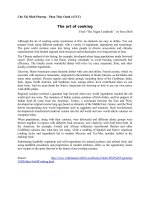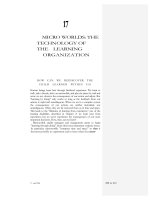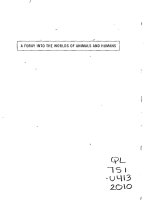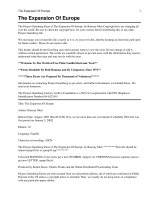the worlds of medieval europe
Bạn đang xem bản rút gọn của tài liệu. Xem và tải ngay bản đầy đủ của tài liệu tại đây (9.44 MB, 479 trang )
The Worlds of Medieval
Europe
Clifford R. Backman
OXFORD UNIVERSITY PRESS
T
H
E
W
O
R
L
D
S
O
F
M
E
D
I
E
V
A
L
E
U
R
O
P
E
This page intentionally left blank
New York Oxford
OXFORD UNIVERSITY PRESS
2003
Clifford R. Backman
BOSTON UNIVERSITY
T
H
E
W
O
R
L
D
S
O
F
M
E
D
I
E
V
A
L
E
U
R
O
P
E
Oxford University Press
Oxford New York
Auckland Bangkok Buenos Aires Cape Town Chennai
Dar es Salaam Delhi Hong Kong Istanbul Karachi Kolkata
Kuala Lumpur Madrid Melbourne Mexico City Mumbai Nairobi
São Paulo Shanghai Singapore Taipei Tokyo Toronto
and an associated company in Berlin
Copyright © 2003 by Oxford University Press, Inc.
Published by Oxford University Press, Inc.
198 Madison Avenue, New York, New York 10016
Oxford is a registered trademark of Oxford University Press
All rights reserved. No part of this publication may be reproduced,
stored in a retrieval system, or transmitted, in any form or by any means,
electronic, mechanical, photocopying, recording, or otherwise,
without the prior permission of Oxford University Press.
Library of Congress Cataloging-in-Publication Data
Backman, Clifford R.
The worlds of medieval Europe / by Clifford Backman.
p. cm.
Includes bibliographical references and index.
ISBN 0-19-512168-6 — ISBN 0-19-512169-4 (pbk.)
1. Civilization, Medieval. 2. Feudalism—Europe. 3. Kings and rulers, Medieval. 4.
Monarchy—Europe. 5. Mediterranean Region—Civilization. 6. Byzantine
Empire—Civilization—1081–1453. I. Title.
D131 .B33 2003
2002066795
Printing number: 9 8 7 6 5432 1
Printed in the United States of America
on acid-free paper
This book is for Scott Austin Backman,
who knows all the things that matter most.
“Counseille me, Kynde,” quod I, “What craft be best to lerne?”
“Lerne to love,” quod Kynde, “and leef alle othere.”
[William Langland, Piers Plowman 20.206–207]
8
This page intentionally left blank
vii
C
ONTENTS
8
acknowledgments xiii
introduction: why the middle ages matter 1
PART ONE T
HE
E
ARLY
M
IDDLE
A
GES
:T
HE
T
HIRD
THROUGH
N
INTH
C
ENTURIES
1T
HE
R
OMAN
W
ORLD AT
I
TS
H
EIGHT
7
The Geography of Empire 7
The Role of the Military 10
Roman Society 12
Roman Government 14
The Challenges of the Third Century 17
Reform, Recovery, Persecution, and Favor 19
Suggested Reading 21
2T
HE
R
ISE OF
C
HRISTIANITY
23
Before Christ 24
The Growth of the New Religion 27
The Problem of Persecution 32
The Problem of Heresy 34
Constantine and Theodosius: An Imperial Church 36
Responses to Imperialization 40
Suggested Reading 46
3E
ARLY
G
ERMANIC
S
OCIETY
48
Germanic Life 49
Migrations and Invasions 54
Europe’s First Kingdoms 57
Germanic Christianity and the Fourth “Doctor of the Church” 64
Suggested Reading 67
4C
LOISTER AND
C
ULTURE
69
The Rise of Monasticism in the East 69
The Rise of Monasticism in the West 73
viii CONTENTS
Cultural Life in the West: Cassiodorus, Boethius, and
St. Benedict 78
Suggested Reading 84
5T
HE
E
MERGENCE OF THE
M
EDIEVAL
W
ORLDS
86
Continuity and Change in Northern Europe 86
Continuity and Change in the Mediterranean 92
The Rise of Islam 99
A Tripartite World 106
Suggested Reading 107
6T
HE
C
AROLINGIAN
E
RA
109
The “Do-Nothing” Kings and the Rise of the Carolingians 110
The Carolingian Monarchy 114
Carolingian Administration 120
Carolingian Society 125
The Carolingian Cultural Renewal 129
Suggested Reading 133
PART TWO T
HE
C
ENTRAL
M
IDDLE
A
GES
:T
HE
T
ENTH
THROUGH
T
WELFTH
C
ENTURIES
7T
HE
T
IME OF
T
ROUBLES
137
Internal Disintegration 137
Trouble from the North 141
Trouble from the East 144
Trouble from the South 145
The End of the World? 149
Suggested Reading 153
8R
EVOLUTIONS ON
L
AND AND
S
EA
155
Changes on the Land 156
A Peasant Society Emerges 160
Changes on the Sea 167
A Maritime Society Emerges 170
Suggested Reading 173
9AN
EW
E
UROPE
E
MERGES
:N
ORTH AND
S
OUTH
175
The Rise of Feudal Society 176
The First German Empire 181
The Rise of Capetian France 187
The Anglo-Norman Realm 189
The Spanish Kingdoms 196
The Italian Scene 201
Suggested Reading 206
CONTENTS ix
10 T
HE
R
EFORM OF THE
C
HURCH
208
The Origins of the Reform 210
The Papal Revolution 216
Christendom and the East 219
Monastic Reforms 227
Suggested Reading 229
11 T
HE
R
ENAISSANCES OF THE
T
WELFTH
C
ENTURY
231
Aristotle, Anselm, Abelard, and ‘Ibn Rushd 232
Law and Canon Law 237
The Recovery of Science 241
The Rise of the Universities 247
Courtly Life, Love, and Literature 252
Suggested Reading 260
12 T
HE
P
APAL
M
ONARCHY
262
Church against State Once More 263
The Consolidation of Papal Authority 267
The Revival of Heresy 273
The Albigensian Crusade and the Origins of the Inquisition 277
Suggested Reading 279
PART THREE T
HE
L
ATE
M
IDDLE
A
GES
:T
HE
T
HIRTEENTH
AND
F
OURTEENTH
C
ENTURIES
13 P
OLITICS IN THE
T
HIRTEENTH
C
ENTURY
283
The Rise of Representative Institutions 284
England and France 286
Germany, Italy, and the Papacy 293
The New Mediterranean Superpowers 296
Byzantium and Islam in the Thirteenth Century 299
Suggested Reading 302
14 A
RT AND
I
NTELLECT IN THE
T
HIRTEENTH
C
ENTURY
304
Scholasticism 305
The Gothic Vision 309
Science and Technology 316
Aspects of Popular Culture 321
Suggested Reading 325
15 D
AILY
L
IFE AT THE
M
EDIEVAL
Z
ENITH
327
Economic Changes 329
Peasants’ Lives 333
Townsfolks’ Lives 337
The Question of Literacy 345
Sex Lives of the Not-So-Rich and the Not-So-Famous 346
Suggested Reading 350
x CONTENTS
16 C
HANGES IN
R
ELIGIOUS
L
IFE
352
The Importance of Being Penitent 353
The Importance of Being Poor 356
The Humanization of Christ and the Cult of the Virgin 361
Mysticism 364
Suggested Reading 367
17 T
HE
C
RISES OF THE
F
OURTEENTH
C
ENTURY
369
Economic Difficulties 370
The Great Famine 373
The Black Death 374
War Everywhere 381
Challenges to Church Unity 387
Suggested Reading 394
18 S
IGNS OF A
N
EW
E
RA
395
William of Ockham 395
Marsilius of Padua 398
Dante Alighieri and Geoffrey Chaucer 400
Christine de Pizan 407
Suggested Reading 408
PART FOUR T
WO
E
PILOGUES
19 C
LOSINGS
I
N
,C
LOSINGS
O
UT
413
The Last Years of Byzantium 415
The Search for a New Route to the East 417
Closing In on Muslim Spain 420
The Expulsions of the Jews 422
Closing In Forever: The Forced Cloistering of Women
Religious 424
Suggested Reading 425
20 T
HE
R
ENAISSANCE IN
M
EDIEVAL
C
ONTEXT
427
Economies New and Old circa 1400 428
The Meaning of Humanism 430
The Canonization of Classical Culture 431
The Rejection of the Middle Ages 435
Suggested Reading 436
appendix a the medieval popes 438
appendix b the carolingians 443
appendix c the capetians 444
CONTENTS xi
appendix d france: the valois 445
appendix e england: the norman and plantagenet
dynasties 446
appendix f england: the lancastrian and yorkist
dynasties 447
appendix g germany: the ottonian, salian, and
hohenstaufen dynasties 448
appendix h germany: thelatemedievalemperors 449
appendix i the spanish kingdoms, 1000–1250 450
appendix j the spanish kingdoms, 1250–1500 451
index 453
This page intentionally left blank
xiii
A
CKNOWLEDGMENTS
8
The time I have spent working on this book has been challenging, humbling, and
exhilarating, and I have learned to depend more than ever on the kindness of
friends. For all their help, patience, and sustaining love, I thank David and Heather
Sundahl, Daniel and Martha Stid, Lisa Lovett and Julie Reuben, Bruce Schulman
and Alice Killian, “Grandma Perc” Thornberg, Bill Wallace, Jim and Laura Woo-
ster, Cheryl and Paul Minor, Bill and Alice King, and Andrea Suess Taylor. Many
colleagues helped out with information, recommendations, and encouragement; I
thank especially Paul Freedman and Caroline Walker Bynum, who showed great
kindness at a particularly difficult time. Nancy Lane, former history editor at Ox-
ford University Press, first persuaded me to write this book, and Gioia Stevens,
Linda Jarkesy, and Peter Coveney helped guide me through to the end. Linda
especially proved helpful during the challenging task of revising the manuscript,
and Peter was an ideal harbor pilot steering the ship into port. I am grateful to
the numerous readers, both faculty-specialists and students, who commented on
the initial prospectus and the subsequent drafts of the manuscript; I have heeded
most of their advice and am solely responsible for all that remains incorrect, mis-
placed, or misleading. My wife Nelina gave her usual scrupulous attention to my
writing style, striving as ever to stamp out the worst of my idiosyncracies. More
than a few of them remain in evidence here despite her best efforts. I am aware
of my many faults as a writer, but I happen to remain rather fond of some of
them. Our six-year-old son Scott sat on my lap and helped me print out the final
copy of the manuscript while waiting patiently for his turn to use the computer;
if there are any errant S-C-O-T-Ts buried in the text, the reader will know whom
to blame.
Eliza McClennen drew the maps that appear throughout the book and has my
thanks for her good cheer and speedy pen. Working with her again after too long
a hiatus was one of the many pleasures I had in writing the book. Several of my
students at Boston University—especially Letta Christianson, Andrew Donnelly,
Ali Glass, and Chris Halfond—helped select the maps and photo illustrations and
suggested source quotations that they had found most enlightening in the class-
room. They will all have been graduated by the time this book appears in print.
I shall miss seeing them around the office.
Each chapter has a Suggested Reading list appended to it. I have tried to make
the lists as up to date as possible and to avoid repetition between them. Each list
recommends pertinent “Texts” (primary sources, usually historical or literary, that
were written in the period that each chapter discusses and that illustrate many of
its chief themes), “Source Anthologies” (collections of primary materials, usually
in abbreviated form and organized around a central topic), and “Studies” (works
xiv ACKNOWLEDGMENTS
of recent scholarship on ideas, events, or people mentioned in the chapter). The
lists make no claim to be comprehensive; I hope they are merely a useful beginning
to further research. I have tried to limit the lists only to books that are still in
print, hence many well-known classics of medieval scholarship are omitted. In the
case of reprints, I have given the publication dates of the most recent editions.
On the matter of dates, I should say that I have chosen to run counter to the
growing trend among historians to use the Common Era. I endorse the use of the
Common Era in general, since it has the attraction of religious non-partisanship
in a religiously heterogeneous society, but at least one aspect of the present book
is the formation of the older tradition itself: how and why western Europe devel-
oped the sort of society that chose the birth of Jesus as its chronometrical focal
point. Thus I use the traditional b.c. (Before Christ) and a.d. (Anno Domini) des-
ignations. My aim throughout, however, is not to endorse a bias but to supply the
context that gave birth to it.
Passages from the Hebrew Bible are quoted from Tanakh: The Holy Scriptures
According to the Traditional Hebrew Text (Jewish Publication Society, 1985); passages
from the New Testament are quoted from The New Jerusalem Bible (revised edition,
1985); and passages from the Qur’an are quoted from The Holy Qur’an: English
Translation of the Meanings, with Commentary (King Fahd Holy Qur’an Printing
Complex, 1410 A.H.). I have borrowed one translation, in Chapter 15, from
Women’s Lives in Medieval Europe: A Sourcebook, edited by Emilie Amt (1993). All
other translations in this book are my own.
T
H
E
W
O
R
L
D
S
O
F
M
E
D
I
E
V
A
L
E
U
R
O
P
E
This page intentionally left blank
1
I
NTRODUCTION
8
Why the Middle Ages Matter
Anyone who has ever laughed her way through Monty Python and the Holy Grail,
felt her soul stir when standing in one of Europe’s great cathedrals, grown excited
when reading about the chivalric exploits of mail-clad knights, or thrilled to the
sounds of Gregorian chant knows that the Middle Ages are fun. There is no harm
in admitting it. Signs of the pleasure we take in medieval life abound in our
culture, from the mock sword fights of our childhood to the prominence of me-
dieval settings in our popular literature and movies, from the crowds that flock
annually to costumed medieval fairs to the groups of college students who enroll
in classes on Chaucer and Dante. Part of our enjoyment derives from the perceived
strangeness of medieval life. Until we become more familiar with them, medieval
people strike us as rather odd: We marvel at their actions or laugh at their ab-
surdities because they seem more unlike us than any other of our ancestors do.
After all, as is well known, people in medieval Europe believed in miracles and
witches. They long thought the surest way to determine whether or not a man
was guilty of a crime was to tie him up and throw him into a lake that been
blessed by a priest.
1
They were convinced that daily bathing was harmful to one’s
health; that magical incantations could transform common metals into gold; that
a reliable method of contraception was for the woman, during intercourse, to wear
a necklace of strung weasel-testicles; that one could rid oneself of toothache by
spitting into the opened mouth of a frog; and that the appearance of comets usu-
ally signified some kind of heavenly favor or disfavor for whatever was happening
in the realm at the time.
But the Middle Ages have a real significance far greater than their entertain-
ment value, and so long as we merely revel in the fun of their uniqueness we will
never fully understand our medieval ancestors or learn what they have to teach
us. The starting assumption of this book, therefore, is that the Middle Ages really
do matter and that studying them is important. The simplest reason for this as-
sertion is that despite initial appearances the medieval world and the modern
world have many things in common, and by understanding the origins of contem-
porary phenomena we gain if not a truer than at least a more sophisticated ap-
preciation of them. How is this so? We can trace a surprising number of modern
ideas, technologies, institutions, and cultural practices back to the medieval cen-
turies—by which we mean the period roughly from 400 to 1400. Parliamentary
government, banks, algebra, mechanical clocks, trials by jury, women playwrights,
polyphonic music, universities, paper mills, citizen armies, distilled liquor, medical
dissection, the novel, law schools, eyeglasses, the modern calendar, insurance
1. If the “pure” water “accepted” the man—that is, if he drowned—he was proved innocent.
2 INTRODUCTION
companies, navigational maps, bookstores, the mafia, and even an early version
of the game of baseball all appeared for the first time in western history in the
Middle Ages. Modern ideas about the nature of citizenship and the authority of
the State, about law and romance, about the need to control the manufacture and
distribution of weaponry, also first materialized in these centuries. Even something
as modern, if not postmodern, as the literary theory of deconstruction has roots
in the medieval philosophers’ debates over Realism and Nominalism, although
those roots stretch back even further to the time of Plato.
Recognizing the medieval/modern connection illumines and enriches our un-
derstanding of the world around us. Why the tradition of college campuses having
their own autonomous police forces? Because universities, when they came into
existence at the very end of the twelfth century, were designed as self-governing
institutions legally independent of the urban communities that housed them. This
tradition is also the origin of the famous “town/gown” tensions that have always
characterized urban universities: Students on boisterous weekend exploits might
damage urban property, but they stood outside the jurisdiction of the urban police.
Why do priests raise the offering of the Mass above their heads when they cele-
brate Communion? Because the medieval Church taught that the faithful had only
to see the bread and wine, not partake of them, in order to receive the spiritual
benefit of the Mass. Needless to say, this practice also reduced the Church’s ex-
penditures on those commodities. How did the popular custom of decorating eggs
and awaiting pleasant bunnies at Easter begin? Peasants on medieval manors
owed a special tax to their lords every Easter Sunday, which, lacking money, they
paid with what they had available.
2
Why do we purchase tourist trinkets when
we travel—such as Eiffel Tower key chains to prove we’ve been to Paris, or beer
steins to commemorate our trips to Munich? Because medieval pilgrims often un-
dertook their voyages as an imposed penance for their sins and had to provide
proof of their successful journeys in order to receive pardon; bringing back a trade-
mark local ware was the easiest way of proving that one had in fact reached one’s
assigned destination. Knowing such things adds a rich texture to our lives that we
should not deprive ourselves of.
While these points are significant by themselves, medieval history has an even
larger importance for modern students. Medieval civilization was an alloy, the
product of the amalgamation of three distinct cultures: classical Rome, Latin Chris-
tianity, and early Germanic society. It was a civilization that, for all its ethnic,
social, and political plurality, regarded itself as an organic whole. The medieval
worldview regarded life as an essential unity—that is, it believed that there existed
a super-arching unifying structure, divinely and naturally ordained, that held to-
gether and gave meaning to the obvious pluralism and diversity of everyday ex-
istence. This unifying vision is the most distinctive characteristic of the medieval
mentality. Whether in terms of its intellectual and artistic life, with their emphases
on the systematizing of knowledge and the integration of motifs, genres, and styles
into larger constructs; or in terms of its political and social life, with their emphases
on state-building and the interdependence of each segment of society in prescribed
roles; or in terms of its ethnic, sexual, and religious relations, with their attempts
to regulate the roles of each group and the rules of their interaction—the principal
thrust of medieval civilization was to connect what was disparate and to find
stability in the multifarious unity that resulted. John of Salisbury, an important
2. That’s right: The Easter bunny was eaten by the nobles.
INTRODUCTION 3
political theorist of the twelfth century, provided an illustration of this belief in
organic wholeness when he likened a political state to the human body:
Those who guide religious life [in any given commonwealth] should be re-
spected and honored as the body’s soul The role of the body’s head is
played by the prince, who is subject only to God and to those who represent
Him on earth and carry out His sacred office, just as in a human body the
head is both animated and governed by the soul. The place of the heart is
filled by the central court, from which all actions, whether good or bad, orig-
inate. Judges and local administrators represent the eyes, ears, and tongue;
and their civil servants and military men correspond to the hands Tax
officials and accountants correspond to the stomach and the intestines
Peasants identify with the body’s feet, since they work upon the soil and
propel the weight of the entire body forward.
Such a mentality categorized individuals and established legal and social hierar-
chies, but the essential cast of this mind was to unite, not to atomize, the distinct
elements of society. It assigned a role for every individual but always integrated
those individuals into the larger social body.
This concern to find and define a collective cultural identity greater than in-
dividual traits of ethnicity, social class, political tradition, and gender is the me-
dieval world’s most lasting legacy; and in light of our contemporary concerns
about social diversity and cultural pluralism—what we often describe as our re-
gard for multiculturalism—the medieval struggle to establish a meaningful, or-
dered sense of heterogeneity within unity takes on a particular relevance, not as
a prescription for how to resolve contemporary issues about individual or group
identity but as an illuminating example of how questions that confront us were
dealt with in the past. Just as in any other aspect of our public and private lives,
it helps to know that other people have confronted similar problems, and we can
learn valuable lessons from their successes and failures.
This book will emphasize the ways in which medieval people sought to rec-
ognize heterogeneity and difference while seeking to create a meaningful unity
out of it, and this emphasis sets us apart from more traditional ways of writing
medieval history. With regard to politics, we will pay less attention to the specific
details of individual rulers than do other books, and will emphasize instead how
the varying political traditions of medieval Europe (generally rural-monarchical
in northern Europe, and urban-communal in the Mediterranean lands) emerged
as responses evolving from different local needs yet aiming at the same goal of
creating a stable ordering of Christian society. We will discuss how techniques of
food production in rural areas, or the regulated ethnic demography of urban cen-
ters (that is, allowing Jews to live in this quarter of the city, Muslims in that quarter,
Venetians over here, Barcelonans over there, etc.) exemplified efforts to modulate
social organization and identity. We will examine phenomena such as scholasticism
and cathedral building as models of how thinkers, architects, and artists sought
to meld vast all-encompassing superstructures of diverse ideas, styles, and tech-
niques into harmonious wholes. And on the darker side, we will consider how
the medieval mania for identifying lepers, heretics, Jews, homosexuals, witches,
criminals, and other general “evil-doers” characterized both a desire to stamp
them out at times, and, at other times, to define their proper (if decidedly inferior)
place in the hustle and bustle of everyday life.
Medieval Europe emerged slowly from the rubble of the fallen Roman Empire
and struggled through several centuries of warfare, poverty, and disease before
4 INTRODUCTION
achieving a tentative, fragile stability under the Carolingian rulers of the eighth
and ninth centuries. After the Carolingians, a second period of disarray descended,
until at some point in the eleventh century Europe quite literally rebuilt itself—
physically, politically, spiritually, economically, and socially—and entered a period
of impressive expansion, wealth, stability, and intellectual and artistic revival.
Many of those gains were lost, as we shall see, in the calamities of the fourteenth
century; but by that point the foundations were securely laid for Europe to move
into the Renaissance with both the technological and economic means, and the
ideological convictions, that would prepare Europe to dominate the globe. The
long centuries of the Middle Ages saw western Europe transform itself from a
sparsely populated, impoverished, technologically primitive, socially chaotic, and
often barbaric place to the world’s wealthiest, best educated, most technologically
developed, and most powerful civilization to date. As we shall see, much of that
transformation depended precisely on the ways in which the many worlds of the
Middle Ages tried to fashion the connections and conflicts of everyday life into a
unified vision of human existence.
Part One
PART ONE
8 8
T
H
E
E
A
R
L
Y
M
I
D
D
L
E
A
G
E
S
T
h
e
T
h
i
r
d
t
h
r
o
u
g
h
N
i
n
t
h
C
e
n
t
u
r
i
e
s
T
h
e
T
h
i
r
d
t
h
r
o
u
g
h
N
i
n
t
h
C
e
n
t
u
r
i
e
s
This page intentionally left blank
7
CHAPTER 1
8
T
HE
R
OMAN
W
ORLD AT
I
TS
H
EIGHT
T
he Roman Empire of the first and second centuries a.d. comprised the larg-
est, wealthiest, most diverse, and most stable society of the ancient world.
No other ancient empire—not the Assyrian, not the Persian, not the Athenian—
had succeeded on such a scale at holding together in harmony so many peoples,
faiths, and traditions. Historians commonly describe these two centuries as the
period of the Pax Romana (“the Roman Peace”), an age when a strong central
government engineered and maintained the social stability that allowed people to
prosper. The sheer vastness of the empire was astonishing: It stretched over three
thousand miles from west to east, from the Strait of Gibraltar to the sources of the
Tigris and Euphrates rivers, and reached northward to Hadrian’s Wall, a fortifi-
cation built in a.d. 122 to protect Roman Britain from the Picts of Scotland, and
southward to the upper edge of the Sahara. Within this vast territory lived as
many as fifty to sixty million people.
The prosperity of those centuries came at a high cost. Rome’s rise to power
was the result of military might, after all, and long centuries of warfare had pre-
ceded “the Roman peace.” In the bloody Punic Wars of the third century b.c. Rome
defeated Carthage, its main rival for control of the western and central Mediter-
ranean, before turning its eyes aggressively eastward and subduing the weakened
Greek states left over from the collapse of Alexander the Great’s empire. But soon
after it had conquered the known world, the Roman state went to war against
itself: Civil wars raged for well over a century as various factions struggled not
only to control the new superstate but to reshape it according to opposing prin-
ciples. Some factions favored preserving the decentralized administrative practices
of the early Republic, while others, such as the faction led by Julius Caesar, cham-
pioned a strong centralized authority; some favored a rigid aristocratic authori-
tarianism, while others promoted a more radically democratic society. These long
wars ended in a bizarre compromise. The empire of the Pax Romana period was
a thoroughly centralized state that delegated most of its day-to-day authority to
local officials; and it was a decidedly hierarchical society, almost obsessive in its
concern to define every individual’s social and legal classification; and yet it re-
mained a remarkably fluid world in which a family could rise from slavery to
aristocratic status in as few as three generations.
Two factors did the most to shape the Roman world and foster its remarkable
vitality and stability: the Mediterranean Sea and the Roman army.
T
HE
G
EOGRAPHY OF
E
MPIRE
The Roman world, like the medieval world that succeeded it, was centered on the
Mediterranean. The sea provided food, of course, but more importantly it
8 THE EARLY MIDDLE AGES
provided an efficient and ready means of transport and communication. When the
Romans referred to the Mediterranean as mare nostrum (“our sea”) they were not
being merely possessive but were in fact recognizing that the sea was the essential
physical infrastructure that held together the entire Roman world. As a general
rule in human history, seas do not divide people; they unite them. This is espe-
cially true of the Mediterranean. Since the Strait of Gibraltar—its opening to the
Atlantic Ocean—measures only eight miles across, the Mediterranean has very
little tide-variation and is naturally protected from all but the worst of Atlantic
storms. With the sea’s smooth waters and temperate climate, sailors from the ear-
liest centuries found it easy to traverse the Mediterranean even in primitive ves-
sels. Moreover, since early navigation relied more on using coastal landmarks than
on steering by the stars, the sea’s natural division into two basins and its abun-
dance of islands and peninsulas enabled traders to reach faraway ports without
ever losing sight of land. These geographical features meant that in Roman times,
and even many centuries before Rome, peoples from regions as far apart as south-
ern Spain and northern Egypt could be, and were, in regular if not continuous
contact with one another.
In fact, they had to be. The Mediterranean basin is surrounded by mountains
along its northern and eastern shores and by deserts along its southern expanse.
This relative shortage of hinterland, coupled with the basin’s characteristic long
summer droughts, meant that most Mediterranean coastal societies had difficulty
producing locally all of the foodstuffs and material goods necessary to life, and
hence they had to trade with one another in order to survive. The physical char-
acteristics of the sea made such contact possible. One should therefore think of
the various cultures of the Mediterranean world as component parts of a single,
large sea-based civilization linked by similar agricultural techniques (the need for
terracing the arid hinterlands and the use of sophisticated irrigation networks, for
example), similar diet (with olive oil, wine, hard grains, and fish predominating),
and similar social organization (the norm was independent coastal cities domi-
nated by trade, and therefore by traders and tradesmen, rather than by large-scale
landowners). Thus when the Romans referred to “our sea” they meant not just
the body of water controlled by the Roman administration, but the body of water
that itself controlled the lives of the empire’s inhabitants.
Roman adminstration of its vast empire would in fact have been impossible
without the sea. No matter what an emperor may have thought of himself and
his authority, his real power extended no further than his ability to enforce his
will, and the qualities of the Mediterranean were such that the emperor’s power
stretched very far indeed. Well-equipped ships fanning out from Rome could scat-
ter throughout the entire sea in two weeks. In ideal sailing weather, for example,
a ship could reach Barcelona in only four days; a fleet setting out for Alexandria
could drop anchor there in little more than a week. This fact allowed Roman law,
and the military muscle needed to enforce it, to be put into direct and effective
practice. The news of local rebellions reached Rome quickly, and Roman forces
were just as quickly dispatched to the trouble spots before the rebellions had a
chance to grow. No land-based empire could hope to possess the political, com-
mercial, and cultural cohesiveness offered by the Mediterranean.
And in fact, it was when Rome began to extend its dominion away from
the sea basin that its first difficulties arose. Rome’s eastward expansion into the
Tigris-Euphrates river valley brought the empire into contact, and instantly
into conflict, with the Parthian Empire, but it was the northern reach of the empire
into western and central Europe that proved the greatest risk to Roman order. A









